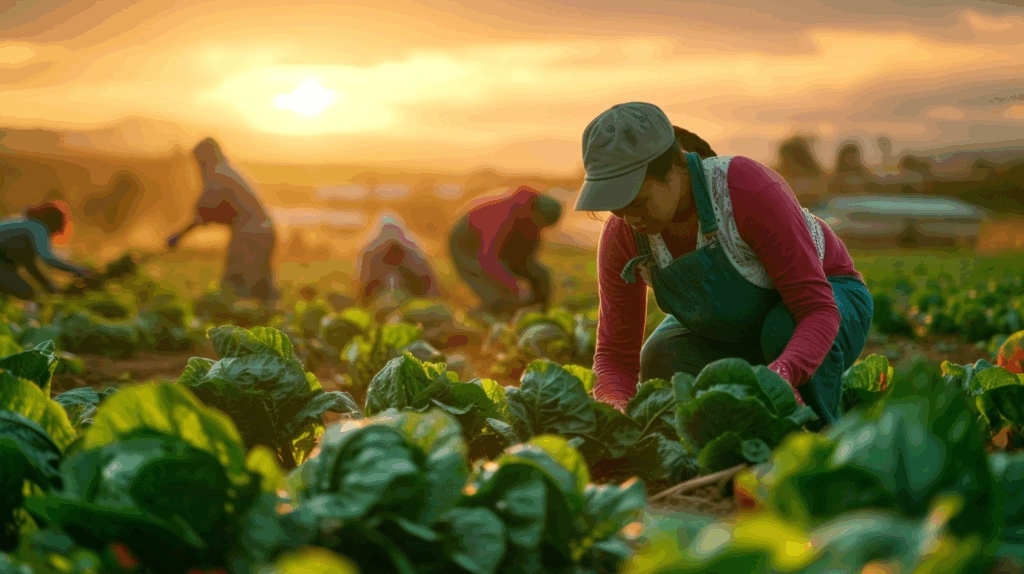Introduction of Organic Farming
Organic farming is a holistic system of agriculture that emphasizes environmental sustainability, food safety, and soil health. Unlike conventional farming, which relies heavily on synthetic fertilizers, pesticides, and genetically modified organisms (GMOs), organic farming focuses on natural inputs and eco-friendly techniques.

At its core, organic farming seeks to work with nature, not against it. This means using biological pest control, organic fertilizers like compost and manure, crop rotation, and biodiversity conservation to ensure long-term agricultural productivity.
In India, organic farming has gained momentum with growing consumer demand for chemical-free food. According to the National Centre of Organic Farming (NCOF), the organic sector has expanded rapidly, with millions of hectares under certification. Globally, organic farming is supported by organizations like the Food and Agriculture Organization (FAO) and the International Federation of Organic Agriculture Movements (IFOAM), reflecting its importance in the fight against climate change and food insecurity.
Related Read: Sustainable Farming: The Future of Agriculture
Importance of Organic Farming
Organic farming goes beyond just avoiding chemicals; it ensures the health of soil, plants, animals, and humans. Its importance can be highlighted through:
- Environmental Protection – Reduces pollution, conserves biodiversity, and enhances ecological balance.
- Healthier Food – Free from harmful chemicals, pesticides, and artificial additives.
- Water Conservation – Minimizes water contamination by avoiding chemical runoff.
- Farmer Benefits – Low input costs, premium market value, and long-term soil fertility.
- Economic Growth – Expanding domestic and global organic food market opportunities.
According to a report by Research and Markets, the global organic food and beverage market is projected to grow significantly by 2030, showing the rising demand for natural and healthy products.
Also check: What is Modern Farming – Methods, Differences & Benefits
Types of Organic Farming
Organic farming is not a one-size-fits-all method. It can be classified into different types of organic farming based on practices, resources, and regional needs.
1. Pure Organic Farming
Pure organic farming strictly avoids all synthetic chemicals, fertilizers, and pesticides. It relies completely on natural manures, compost, farmyard manure, green manure, bio-fertilizers, and biological pest control.
Key Practices in Pure Organic Farming:
- Exclusive use of organic inputs
- Indigenous seed preservation
- Natural pest deterrents like neem extracts
This type is most suitable for small farmers or those aiming for certified organic products.
2. Integrated Organic Farming
Integrated organic farming blends traditional organic practices with modern scientific approaches. It emphasizes efficient resource utilization by integrating crop production, animal husbandry, aquaculture, and agroforestry.
Key Practices in Integrated Organic Farming:
- Crop-livestock integration
- Renewable energy use (biogas, solar power)
- Vermicomposting and waste recycling
This system ensures self-sufficiency and reduces dependence on external inputs, making farms more economically viable.
3. Other Classifications of Organic Farming
While the above two are the primary categories, organic farming can also be understood through:
- Permaculture – Designing farms as self-sustaining ecosystems.
- Biodynamic Farming – Introduced by Rudolf Steiner, incorporating cosmic rhythms and natural preparations.
- Natural Farming (Zero Budget Farming in India) – Promoted by Subhash Palekar, it avoids all external inputs, relying on cow dung, cow urine, and natural processes.
For more insights, explore: Natural Farming vs Organic Farming
Components of Organic Farming
To achieve success, organic farming depends on several interlinked components that work together for sustainability.
1. Soil Management
Healthy soil forms the foundation of organic farming. Organic farmers use compost, cover crops, crop rotation, and mulching to maintain soil fertility, enhance microbial activity, and prevent erosion.
2. Crop Diversity
Crop rotation and intercropping prevent pest build-up, reduce disease risks, and maintain soil nutrients. For example, legumes enrich soil nitrogen naturally.
3. Organic Fertilizers & Manures
Instead of synthetic fertilizers, farmers use:
- Compost & vermicompost
- Green manures (sunhemp, clover)
- Farmyard manure (FYM)
These improve soil structure and nutrient content.
4. Pest & Weed Management
Biological pest control, neem oil sprays, pheromone traps, and natural predators help manage pests. Weeds are controlled by mulching, manual removal, and cover crops.
5. Livestock Integration
Livestock provides manure, milk, draft power, and enhances farm diversity. Integrated farming systems combine poultry, dairy, and aquaculture with crops for maximum efficiency.
6. Water Management
Efficient irrigation methods like drip irrigation, rainwater harvesting, and water recycling are essential for organic farming.
7. Certification & Standards
Certification ensures trust and marketability of organic products. In India, APEDA oversees certification under the National Programme for Organic Production (NPOP).
Related Article: Hybrid Vegetable Seeds: A Complete Guide
Benefits of Organic Farming
- Produces nutrient-rich, chemical-free food
- Improves soil fertility and health
- Promotes sustainable agriculture
- Increases farm biodiversity
- Creates better income opportunities for farmers due to premium pricing
According to FAO, organic farming contributes significantly to climate change mitigation by reducing greenhouse gas emissions and increasing carbon sequestration in soils.
Challenges in Organic Farming
While organic farming has clear benefits, it also faces some challenges:
- Lower yields compared to conventional farming
- Higher labor requirements
- Certification costs and processes
- Limited market access in some regions
However, with government support, awareness, and better infrastructure, these challenges can be addressed.
External Reference: FAO – Organic Agriculture
Conclusion
The introduction of organic farming highlights how it has become an essential agricultural practice for a healthier planet and population. The various types of organic farming—pure, integrated, and natural—offer flexibility for farmers to adopt based on their resources. Furthermore, the components of organic farming such as soil management, crop diversity, livestock integration, and pest control ensure sustainable long-term benefits.
By promoting eco-friendly farming methods, organic farming supports environmental conservation, rural development, and food safety. For farmers and consumers, this system is more than just agriculture—it is a way of life that ensures a better future for generations to come.
Stay updated with farming practices and tips at Agzora.
FAQs
Q1: What is organic farming in simple words?
Organic farming is a method of growing crops and raising animals without using synthetic chemicals, focusing on natural inputs and sustainability.
Q2: What are the two main types of organic farming?
The two main types are Pure Organic Farming and Integrated Organic Farming.
Q3: What are the key components of organic farming?
Soil management, crop diversity, organic manures, pest control, livestock integration, and water management.
Q4: Is organic farming profitable in India?
Yes. With growing consumer demand and government support, organic farming is becoming increasingly profitable, especially for export markets.
Q5: What is the difference between natural and organic farming?
While both avoid chemicals, natural farming (like Zero Budget Natural Farming) avoids even organic fertilizers, while organic farming allows compost and manure.






